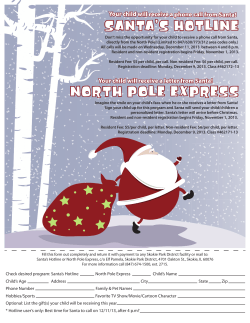
Document 230994
A COOPERATIVE PROJECT OF THE SANTA BARBARA NEWS-PRESS AND THE EDUCATORS’ ROUNDTABLE, PUBLISHED MONTHLY TO PROMOTE LEARNING AMONG YOUNG READERS IN NATURAL SCIENCE, HISTORY, TECHNOLOGY, AND ART This Month’s Theme: How to Attract Wildlife to Your Garden GET CONNECTED WITH THE MEMBERS OF THE EDUCATORS’ ROUNDTABLE: Channel Islands National Marine Sanctuary 805-966-7107; www.channelislands.noaa.gov Santa Barbara Mission Museum 805-682-4149 Santa Barbara Trust for Historic Preservation 805-965-0093; www.sbthp.org Ganna Walska Lotusland 805-969-3767; www.lotusland.org Santa Barbara Botanic Garden 805-682-4726; www.sbbg.org Channel Islands National Park 805-658-5730; www.nps.gov/chis Santa Barbara Maritime Museum 805-962-8404; www.sbmm.org Marine Science Institute, UCSB 805-893-8765 www.msi.ucsb.edu Santa Barbara Historical Museum 805-966-1601 Rancho La Patera and Stow House Your garden may be near your house, beside your apartment, at your school, or it may even be in a barrel or a window box. It is fun to attract wildlife to your garden because then you can watch the animals closely and learn about them. If you don’t have a garden of your own, you can always see lots of wildlife if you visit the Santa Barbara Botanic Garden. What kinds of wildlife might visit your garden? Birds, butterflies, and moths are always exciting visitors. Some animals can cause trouble in a garden, and so you probably don’t want to attract creatures like deer, gophers, moles, ground squirrels, or skunks. You may even need to figure out how to keep these mammals out of your garden. Butterflies and Moths Butterflies and moths undergo metamorphosis so they have complicated life cycles. Larvae or caterpillars generally munch on leaves, while adult butterflies and moths often feed on nectar. The winged adult forms of some species live for only a short time and do not feed at all. If you plant certain types of plants in your garden, you will be able to attract many types of butterflies and moths. Beautiful big Ceanothus Silk Moths lay their eggs on Ceanothus bushes and their big green caterpillars eat the leaves of these Colorful zinnias attract butterflies. A hungry ceanothus moth caterpillar 805-964-4407; www.goletahistory.org plants. Monarch Butterflies lay their eggs on milkweed plants, and their caterpillars often eat all of their leaves in a few days. There are many websites Elverhoj Museum 805-686-1211 www.elverhoj.org/ Santa Barbara Public Library System 805-962-7653; www.sbplibrary.org Kids do Ecology National Center for Ecological Analysis and Synthesis 805-892-2500 http://kids.nceas.ucsb.edu/ Carriage and Western Art Museum of Santa Barbara 805-962-2353; www.carriagemuseum.org Cachuma Lake Nature Center, Inc. 805-693-0691 University Art Museum, UCSB 805-893-2951 www.uam.ucsb.edu Santa Barbara Museum of Natural History www.sbnature.org; 805-682-4711 Santa Barbara Zoological Gardens Ceanothus silk moth from which you can learn what types of plants best attract butterflies and moths. Here is the website of a native plant nursery that has a lot of good information: http://laspilitas.com/butterfl.htm Native plants are especially attractive to native insects. Some nonnative plants are also very attractive. Good plants to include in a beautiful butterfly garden are zinnias of many colors, yarrow, lavender, verbena, and milkweed. A Checkerspot butterfly on purple sage 805-962-5339 www.sbzoo.org Santa Barbara County Parks 805-568-2461 www.sbparks.com Santa Barbara Contemporary Arts Forum The bright yellow California dogface is California’s State Butterfly. 805-966-5373; www.sbcaf.org Art From Scrap 805-884-0459 www.artfromscrap.org USDA Forest Service, Los Padres National Forest 805-968-6640 www.fs.fed.us/r5/lospadres South Coast Railroad Museum 805-964-3540; www.goletadepot.org Wildling Art Museum Ty Warner Sea Center 805-688-1082 www.wildlingmuseum.org 805-962-2526 www.sbnature.org The Outdoor School at Rancho Alegre 805-686-5167 www.theoutdoorschool.org 805-967-7369 The Center for Urban Agriculture at Fairview Gardens www.fairviewgardens.org Birds In order to attract birds to your garden you can buy birdbaths and feeders, but it is more fun to make them yourself. Always be sure hang them out of reach of cats. To make a bird bath: Birds will splash around in a bird bath and they will drink from it also. Ask an adult to drill or poke three holes spaced at equal distances around the rim of a lightweight metal or plastic bowl. Tie a long string through each of the three holes, and then tie the strings together to make the hanger. Hang your new bird bath in a tree and fill it with one or two inches of water. To make a pine cone bird feeder: Find a big pine cone. Tie a long string to the stem end of the cone. Roll the cone in peanut butter and then roll it in bird seed so that the seed sticks to the peanut butter. Hang the cone in a tree with the string. To make a coconut bird feeder: Buy a whole, mature coconut. Ask an adult to drill holes or punch holes with a hammer and nail through the three round marks at the top Coconut bird feeder of the woody shell. You will thread a string through these holes when you are ready to hang up your feeder. Pour out the coconut juice and save it for drinking. Ask the grown-up to saw the side off the shell so that there is a cave-like place for birds to stand. Remove the delicious white nut meat from the inside. You can eat it in chunks or you can grate it to use when you bake cakes or cookies. Now hang the feeder in a tree and pour bird seed in it. Some people put melted lard or bacon fat mixed with seeds in their coconut bird feeders. Flowers are hummingbird feeders: Hummingbirds feed on nectar from flowers and so the best kind of feeders you can provide A hummingbird feeds from hummingbird sage. for them are suitable types of flowers. Hummingbirds like long tubular flowers with lots of nectar. They are attracted especially to red and magenta flowers like those of our native Hummingbird Sage and California Fuchsia. Now sit still, be very quiet, and watch for birds! If you have binoculars be sure to use them. Frogs and Toads Hop to it! Frogs and toads are fun to watch, and they will eat insects that could harm your garden. Follow the directions below to create a habitat for toads in your backyard. You will need: One clay flowerpot Permanent markers or paint One small rock 1. Use the markers or paint to decorate Chorus frogs eat flies. the outside of your flowerpot. Give the paint plenty of time to dry! 2. Find a spot near your house where the ground is wet and there is plenty of shade. The best spots are patches of dirt that get lots of water and are shaded by a plant or building. 3. Find some fallen leaves or grass clippings. Create a bed of leaves in the spot you’ve chosen for your toad abode (house). The toad will hide under these leaves to stay cool. 4. Set your flowerpot upside down on your chosen spot. Use a small rock to prop up one edge so A toad abode is easy to make. that a toad can crawl in. 5. Wait. Try to leave your toad abode alone. If you check on it, you may scare away any toads that might want to move in! 6. Listen. The best way to know if you have a toad is to go outside right after the sun goes down and listen. A big toad Do you hear croaking? Now you can enjoy your time in your garden with fewer insect pests. Page by Sally Isaacson, Santa Barbara Botanic Garden and Katie Holder, Santa Barbara Zoo Photos by Sally Isaacson
© Copyright 2025





















